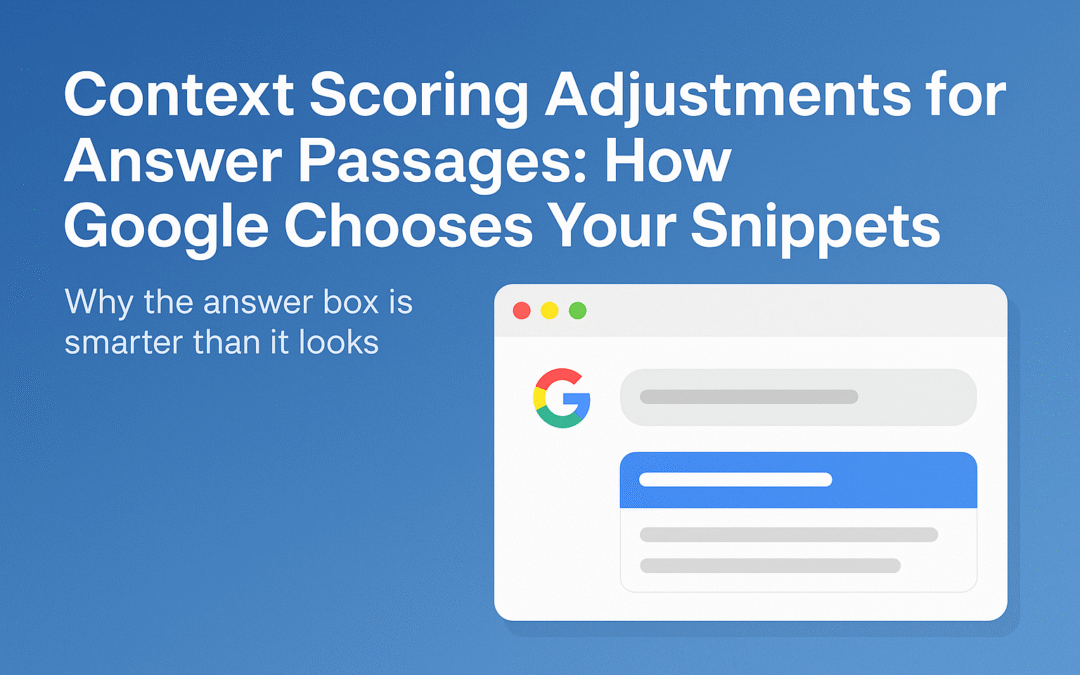If you’ve ever typed a question into Google and gotten that little box at the top with the “best” answer, you probably thought, “Cool, the robots saved me a click.” But behind the curtain, Google is running a whole scoring system that makes picking those snippets way more complicated than it seems.
In fact, Google even patented the process. It’s called “Context scoring adjustments for answer passages” (US11409748B1, United States), and you can read the full thing here if you’re in the mood for 60 pages of bedtime material. Don’t worry though, I’ll give you the short-and-readable version.
How It Works in Plain English
When you ask a question, Google pulls together a bunch of possible answer passages from different pages on the web. Each passage starts with a basic score based on things like keyword matching. But here’s the trick: Google doesn’t stop there. It runs a context check to figure out which passage is most likely to truly answer your question.
That context check looks at:
- Headings and hierarchy.
Every web page has headings (H1, H2, H3, etc.). If the passage lives right under a heading that matches your question, it gets extra credit. Example: You ask “How far is the moon from Earth?” A passage under the heading “The Distance from Earth to the Moon” is going to outrank one under *“Fun Facts About Space.” - Depth in the document.
Passages buried deeper under multiple headings often look more focused, so they may get boosted over shallow “intro paragraph” answers. - Coverage ratio.
Google checks how much of the section the passage actually covers. A single throwaway line? Not so strong. A solid chunk that covers most of the section? Much better. - Nearby questions.
If the answer appears right after a clear question, it feels more trustworthy. Example: Heading says “Why is the moon’s distance changing?” and the next passage explains elliptical orbits. Boom, that gets a score bump. - Lists and how-tos.
If your query is a “how to” type (change a tire, install a doorknob, bake sourdough), Google loves a clean list of steps. Numbered lists and bulleted instructions are like catnip for the algorithm.
A Quick Example
Let’s say there are three candidate answers on a page about the moon:
- “It takes about 27 days for the Moon to orbit the Earth…”
- “Why is the distance changing? The Moon’s orbit is elliptical, so the distance varies from 225,700 miles to 252,000 miles.”
- “The Moon’s distance from Earth varies because of its slightly elliptical orbit…”
At first, #2 might look like the winner because it’s wordy and complete. But when context scoring kicks in, #3 gets boosted higher because it follows a clear heading, matches the query wording better, and sits neatly in the document structure.
Result: passage #3 shows up in the answer box, not #2.
Why This Matters for You
You might be thinking, “Cool, but why do I care?” Well, if you’re writing online content, this is a blueprint for making your answers the ones Google picks up.
Here’s what you can do:
- Use clear, specific headings that sound like real questions people search for.
- Put the answer right under the heading. Don’t bury it in fluff.
- For “how-to” content, go with a step-by-step list.
- Make sure your answer covers enough ground… more than a one-liner, but not an essay.
It’s basically like setting the table for Google: give it a nice, obvious heading, a clear answer right after, and some structure around it, and it’s more likely to serve your passage at the top.
Final Thought
The patent US11409748B1 boils down to one big idea: Google doesn’t just rank passages based on keywords. It also cares about where the answer lives on the page and whether the context makes it feel reliable.
Obviously, the robot overlords are going to keep tweaking the formula, but if you stick to strong headings, clear answers, and solid structure, you’re already speaking Google’s love language.
And hey… next time you see that quick answer box, you’ll know it wasn’t magic. It was context scoring. Not as sexy a name, but it gets the job done.

